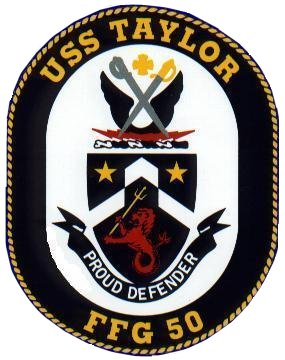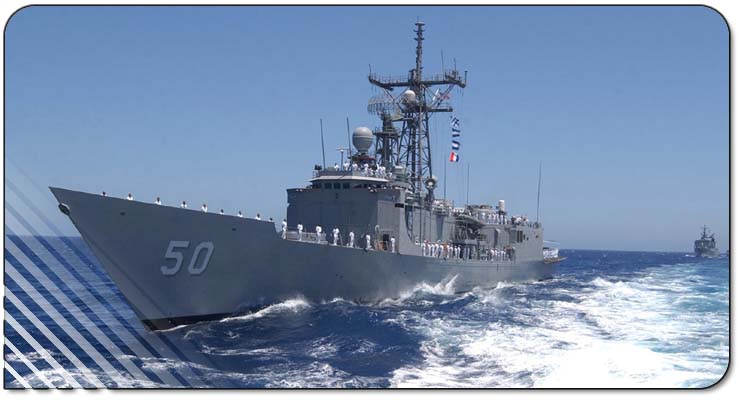Namesake:
Commander Jesse Junior Taylor
Commander Taylor was born in Wichita, Kansas on 16 January 1925. He
enlisted in the Navy in October 1942, and served as an Aviation
Radioman until the end of World War II with Bombing Squadron VB-II
aboard the carrier USS HORNET in the South Pacific.
During the Korean conflict, he returned to the Navy for training as a
Naval Aviator and, in May 1952, received his commission as an Ensign.
After a tour with Composite Squadron Four, he served as NROTC
Instructor at the University of California at Los Angeles. Further
flight training and a tour with the Staff of Chief, Naval Air Training
followed at NAS Pensacola, Florida. He was promoted to Lieutenant
Commander while serving with VF-174. He attended the Naval War College
in Newport, Rhode Island, and directed the Flight Division of the
Bureau of Naval Weapons at St. Louis, Missouri for two years.
In July 1965, LCDR Taylor was assigned to Air Wing 16 aboard the attack
carrier USS ORISKANY, and sailed to the Western Pacific. He flew 16
missions between September and November, earning an Air Medal and a
Gold Star in lieu of a second award. Advanced to the rank of Commander
on 1 September 1965 he had not been officially given the rank at the
time of his death.
On 17 November 1965, Commander Taylor was flying his A-1 Skyraider
during attacks on a key bridge near the North Vietnamese Port of
Haiphong. Ground fire had downed one of the other Navy aircraft, and
its pilot had ejected in a heavily defended area. Commander Taylor
heard the radio transmission describing the pilot's plight. Realizing
that time was of the essence in any attempt to rescue the downed pilot,
Commander Taylor made a courageous decision. Although it was not his
assigned mission, and having discovered that other rescue aircraft were
occupied elsewhere, he took command of the rescue effort.
Commander Taylor proceeded to the scene and found the pilot still in
his parachute harness in shallow water. To cover the approach of the
rescue helicopter, Commander Taylor attacked the anti-aircraft gun
sites despite intense and accurate anti-aircraft fire and the fact that
his own plane had sustained damage. The storm of enemy fire made it
impossible for the helicopter to rescue the man on the ground.
Meanwhile, because of fire in his own aircraft, Commander Taylor was
forced to break off his own persistent attacks. Rather than abandon his
plane in enemy territory, he elected to try to ditch in the Gulf of
Tonkin. However, the fire burned through the wing of his plane, and it
crashed before he had time to leave it.
For his heroic determination to save a fellow pilot, even at great risk
to his own life, Commander Taylor was posthumously awarded the Navy
Cross.
|
Ship's Crest:
 The Shield:
The blue shield represents the U.S.
Navy, and the oceans of the world on which it sails. The chevron refers
to Commander Taylor's naval career; its three segments representing the
three conflicts during which he served - World War II, Korea and
Vietnam. The two gold stars represent the two previous U.S. Navy
destroyers which have borne the name Taylor. The first, Destroyer No.
94, was laid down in 1917 at the Mare Island Navy Yard and was stricken
from the Navy List in 1938. The second, DD 468, was laid down in 1941
at Bath Iron Works, and earned a total of 23 Battle Stars for action in
World War II, Korea and Vietnam. She was stricken in 1969. The sea lion
refers to Commander Taylor's courage and selfless dedication to duty.
The sea lion holds a trident, traditionally the symbol of sea power, to
symbolize further the three aspects of modern naval warfare in which
TAYLOR is a potent adversary - subsurface, surface and air. The use of
silver and scarlet with the traditional blue and gold of the U.S. Navy,
represents Commander Taylor's shining ideals and gallant self-
sacrifice in defense of a fellow aviator. The Shield:
The blue shield represents the U.S.
Navy, and the oceans of the world on which it sails. The chevron refers
to Commander Taylor's naval career; its three segments representing the
three conflicts during which he served - World War II, Korea and
Vietnam. The two gold stars represent the two previous U.S. Navy
destroyers which have borne the name Taylor. The first, Destroyer No.
94, was laid down in 1917 at the Mare Island Navy Yard and was stricken
from the Navy List in 1938. The second, DD 468, was laid down in 1941
at Bath Iron Works, and earned a total of 23 Battle Stars for action in
World War II, Korea and Vietnam. She was stricken in 1969. The sea lion
refers to Commander Taylor's courage and selfless dedication to duty.
The sea lion holds a trident, traditionally the symbol of sea power, to
symbolize further the three aspects of modern naval warfare in which
TAYLOR is a potent adversary - subsurface, surface and air. The use of
silver and scarlet with the traditional blue and gold of the U.S. Navy,
represents Commander Taylor's shining ideals and gallant self-
sacrifice in defense of a fellow aviator.
The Crest: The wings represent
Commander
Taylor's service as a Naval Aviator. The scarlet lightning flash refers
both to his service as an Aviation Radioman and to his relentless
attacks on enemy gun positions during the rescue attempt which cost him
his life. The gold cross represents the Navy Cross awarded him
posthumously for his heroism. The crossed swords represent the officers
and enlisted personnel of the U.S. Navy who have given their lives
around the globe as proud defenders of freedom and their country.
|

